So many great birds, turtles and wildlife over at this peaceful pond.


My View of Life on the Dock
So many great birds, turtles and wildlife over at this peaceful pond.


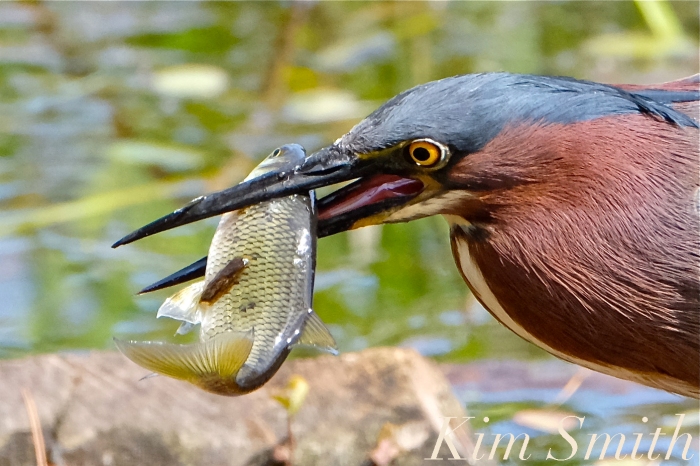 You never know what gift of beauty you will encounter in the “wild woods” of Cape Ann. I never leave home without my cameras and today was a perfect example why. Traveling the scenic way between jobs, I passed a stunning little Green Heron whose rich teal and maroon colored feathers were shimmering in the mid morning sun. I had to pull over, thinking I would at best take a few snapshots because in previous encounters, Green Herons usually fly away quickly. The bird tolerated me for some time as I watched him do a slow, stealthy dance around the pond’s edge, catching small minnows as he went. Imagine how delightful to then see him catch a fish as large as his dagger-like bill!!
You never know what gift of beauty you will encounter in the “wild woods” of Cape Ann. I never leave home without my cameras and today was a perfect example why. Traveling the scenic way between jobs, I passed a stunning little Green Heron whose rich teal and maroon colored feathers were shimmering in the mid morning sun. I had to pull over, thinking I would at best take a few snapshots because in previous encounters, Green Herons usually fly away quickly. The bird tolerated me for some time as I watched him do a slow, stealthy dance around the pond’s edge, catching small minnows as he went. Imagine how delightful to then see him catch a fish as large as his dagger-like bill!!
Green Herons eat a wide variety of fish and small creatures including minnows, sunfish, catfish, pickerel, carp, perch, gobies, shad, silverside, eels, goldfish, insects, spiders, crustaceans, snails, amphibians, reptiles, and rodents.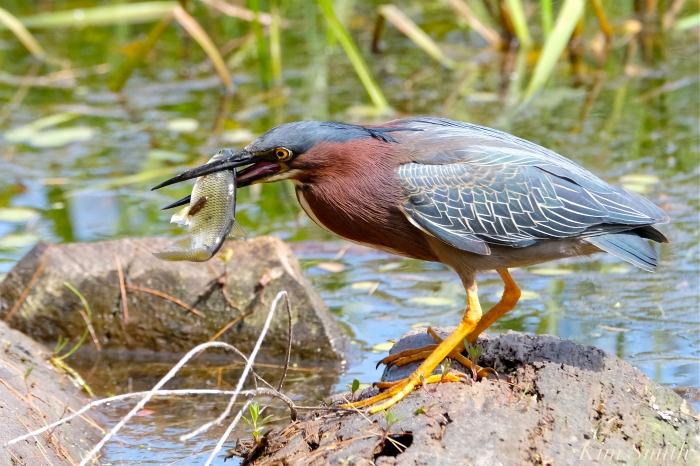
One large fish devoured in one large gulp!
The Green Heron is found throughout the US but is a species in decline in most regions, except California, where the bird appears to be increasing. Green Herons breed in Massachusetts coastal and inland wetlands.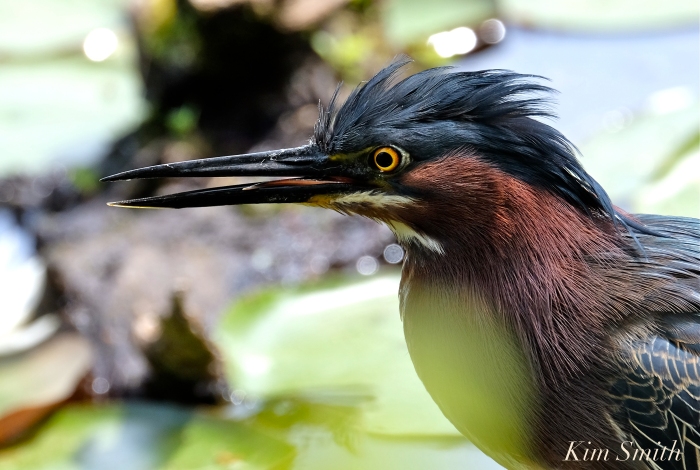
 Our Niles Pond rescue swan has survived her second night! She is still not venturing far from the reeds. Mr. Swan is definitely aware of her presence but is playing coy and for the most part, ignoring her. The good news, or great news I should say, is that he is not chasing and threatening her.
Our Niles Pond rescue swan has survived her second night! She is still not venturing far from the reeds. Mr. Swan is definitely aware of her presence but is playing coy and for the most part, ignoring her. The good news, or great news I should say, is that he is not chasing and threatening her.
New Swan is continuing to feed on pond vegetation. I didn’t get a glimpse of her until around 11am when the light was very harsh, but here she is at the pond’s edge, photo bombed by a stealthy Green Heron.

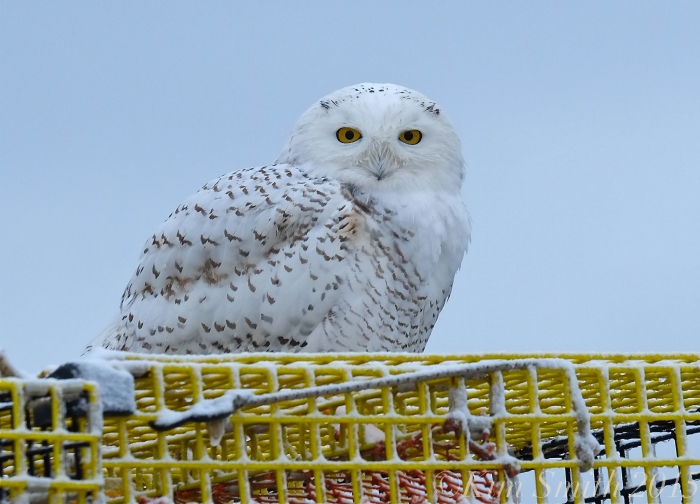 My husband Tom suggested that I write a year-end post about the wildlife that I had photographed around Cape Ann. Super idea I thought, that will be fun and easy. Many hours later (not realizing how daunting) the following is a collection of some favorite images from this past year, beginning with the male Snowy Owl photographed at Captain Joe’s last winter, to December’s Red-tailed Hawk huntress.
My husband Tom suggested that I write a year-end post about the wildlife that I had photographed around Cape Ann. Super idea I thought, that will be fun and easy. Many hours later (not realizing how daunting) the following is a collection of some favorite images from this past year, beginning with the male Snowy Owl photographed at Captain Joe’s last winter, to December’s Red-tailed Hawk huntress.
Living along the great Atlantic Flyway, we have been graced with a bevy of birds. Perhaps the most exciting arrival of all occurred when early summer brought several pairs of nesting Piping Plovers to Gloucester’s most beloved (and most highly trafficked) of beaches, Good Harbor Beach. Their story is being documented on film.
Work on Mr. Swan’s film will also resume this January—the winters are simply not long enough for all I have planned!
While photographing and filming Red-winged Blackbirds this past spring, there was a face-to-face encounter with a hungry coyote, as well as several River Otter sightings.
 The summer’s drought brought Muskrats out from the reeds and into full view at a very dry Henry’s Pond, and a short film about a North American Beaver encounter at Langsford Pond. Numerous stories were heard from folks who have lived on Cape Ann far longer than I about the extraordinary number of egrets, both Snowy and Great, dwelling on our shores.
The summer’s drought brought Muskrats out from the reeds and into full view at a very dry Henry’s Pond, and a short film about a North American Beaver encounter at Langsford Pond. Numerous stories were heard from folks who have lived on Cape Ann far longer than I about the extraordinary number of egrets, both Snowy and Great, dwelling on our shores.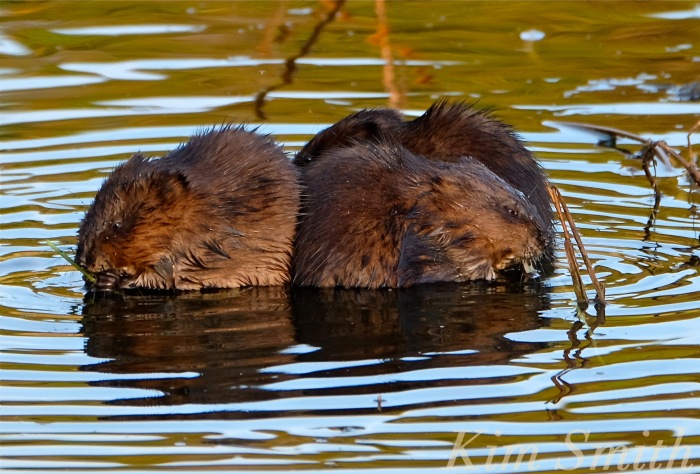
There were few Monarch sightings, but the ones seen thankfully deposited eggs in our garden. Thank you to my new friend Christine who shared her Cecropia Silkmoth eggs with me and thank you to the countless readers who have extended an invitation to come by and photograph an exciting creature in their yard.
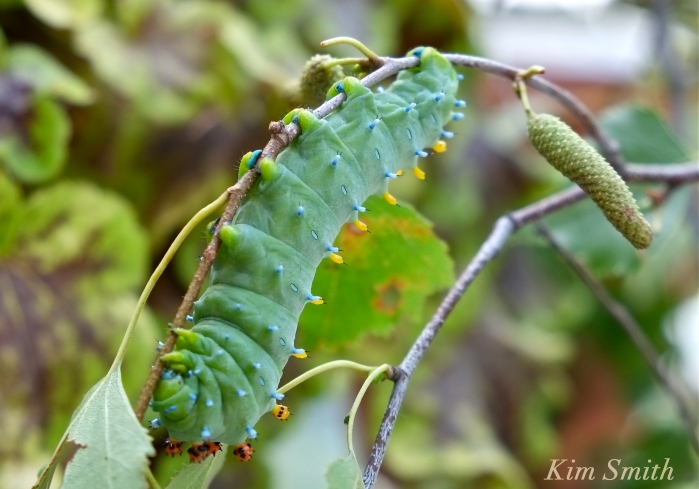 Pristine beaches, bodies of fresh water, and great swathes of protected marsh and woodland make for ideal wildlife habitat, and Cape Ann has it all. With global climate change pushing species further away from the Equator, I imagine we’ll be seeing even more creatures along our shores. Butterfly and bee populations are overall in decline, not only because of climate change and the use of pesticides, but also because of loss of habitat. As Massachusetts has become less agrarian and more greatly forested, fields of wildflowers are becoming increasingly rare. And too fields often make the best house lots. Farmers and property owners developing an awareness of the insects’ life cycle and planting and maintaining fields and gardens accordingly will truly help the butterflies and bees.
Pristine beaches, bodies of fresh water, and great swathes of protected marsh and woodland make for ideal wildlife habitat, and Cape Ann has it all. With global climate change pushing species further away from the Equator, I imagine we’ll be seeing even more creatures along our shores. Butterfly and bee populations are overall in decline, not only because of climate change and the use of pesticides, but also because of loss of habitat. As Massachusetts has become less agrarian and more greatly forested, fields of wildflowers are becoming increasingly rare. And too fields often make the best house lots. Farmers and property owners developing an awareness of the insects’ life cycle and planting and maintaining fields and gardens accordingly will truly help the butterflies and bees.
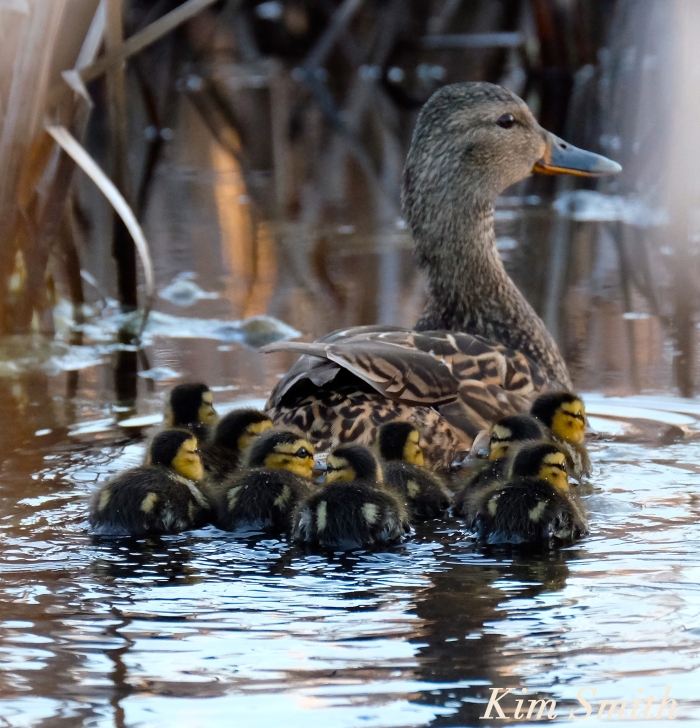 Thank you to all our readers for your kind comments of appreciation throughout the year for the beautiful wild creatures with which we share this gorgeous peninsula called Cape Ann.
Thank you to all our readers for your kind comments of appreciation throughout the year for the beautiful wild creatures with which we share this gorgeous peninsula called Cape Ann.
The images are not arranged in any particular order. If you would like to read more about a particular animal, type the name of the animal in the search box and the original post should come up.
I wonder what 2017 will bring?
What mystery bird, new to my eyes, was I seeing as it cautiously appeared from the knot of tall reeds? Its neck extended like a heron’s, but was smaller in size than even the Black-crowned Night Heron. I caught a glimpse and then waited for movement, and then waited, and then waited some more when the furtive bird at last flew into a tangle of trees where its shape was unfortunately barely distinguishable. I took a few photos knowing they would be far too grainy to post, thinking nonetheless that a photo would be at least useful for a bird id. Suddenly the mystery bird took flight to the far end of the pond, landing at the water’s edge. I stealthily made my way over and for a few moments had a clear view through the emerging grass and cattails and was able to both film and photograph.
The neck of the male Green Heron is a striking chestnut color and the wing backs are a gorgeous velvety deep greenish-blue gray. As usual, the female’s plumage is more subduedly colored. Green Herons begin to arrive in Massachusetts in May, where they will stay through the summer, dispersing southward in September. The heron’s population is concentrated around inland wetlands and coastal marshes.
From reading several species accounts, the Green Heron’s claim to fame is that it is one of the few animals that utilizes tools to capture prey. It will float a stick or bread crust on the water’s surface to lure small fish, tadpoles, and crayfish. Wouldn’t that be amazing to film! Green Heron’s also eat small snakes, earthworms, and insects.